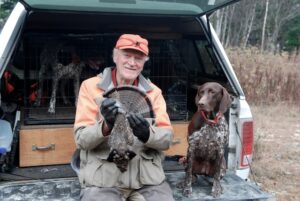Grouse Hunting Basics

By Paul Fuller
Due to last year’s outstanding grouse season, I’ve never had so many emails asking about grouse hunting. Plus, most of the major grouse camps are booked for this fall. You can separate yourself from the maddening crowd by being just a little smarter about your approach to grouse hunting. Here’s how.
Like most living things, there are two major requirements for staying alive: food and shelter. Combine the two and we have what the biologists refer to as habitat.
Grouse Food
Let’s address grouse food first. I break down grouse food sources during the season into three periods. The first period is during early season grouse hunting. During this period, the grouse food plate is huge. The entire forest is one big dinner plate. Biologists have identified over 500 plant species, when green, that the grouse eat. High on the list are wild strawberry leaves, clover and wild raspberry leaves. Since the food plate is so big, it’s difficult to find a grouse “hot” spot. They could be anywhere. If you hunt with bird dogs, find what appears to be good habitat and just let the dogs do the work.
If you don’t hunt with dogs, find logging roads with clover in the ditches. Slowly walk the roads and you’ll very often get flushes from the ditch. There is nothing more satisfying then shooting a grouse on the wing. Another tip is if you’re driving the roads and see a grouse run into the woods, send a friend around to head it off. One stays on the road. One of the two will often get an on-the-wing shot. Great fun and fair chase.
The Season
The second period is what I refer to as mid-season. In New England, that’s usually the third and fourth week of October. By then, there has usually been a frost. The frost kills much of the green; clover and strawberry leaves turn brown which means they have no nutritional value. Nuts, berries and apples are the favorite foods during the second period. Nuts and berries are usually in most good grouse cover, however, apples will require an old abandoned farm. Find the orchard on that old abandoned farm and you’ll have a jackpot. For nuts, look for acorns, beech and hickory. All very tasty for the grouse. For berries, watch for mountain ash, high bush cranberries and grapes. The mountain ash and high bush cranberries will grow wild through seeds dropped from bird poop. For grapes, you’ll need one of those old abandoned farms.
The third food period during hunting season, starting in November, consists of tree buds and rose hips. For tree buds, look for aspen and black cherry in the more wild landscape. Where you’ve found that precious abandoned apple orchard, those trees keep on giving; the buds are a delicacy for the grouse. Tree buds are what primarily feed the grouse throughout the winter.
Shelter
Now let’s address shelter. Shelter provides the grouse with protection from severe weather and predators. The best shelter is a mixture of young hard wood growth and conifers. Both, due to density, provide enough shelter to prevent aerial predators from penetrating the foliage. Grouse are edge birds. They like habitat that allows them to move short distances from shelter to food. Find a thick conifer stand that borders food and you’ll find grouse.
If you’re hunting solo and on-foot, remember that grouse move more frequently early morning and late afternoon. And, the same if you’re hunting with bird dogs. For dogs, the bird scent required for pointing is strongest when the bird is moving. Scent rises into a scent cloud when the bird is warm which comes from moving. Temperatures between 40 and 60 are considered the best for bird scent and dog work.
Susan and I hope you have a great upland season.
Paul and Susan, his wife, host the Bird Dogs Afield TV show. All past episodes may be watched on his website: www.birddogsafield.com. Also, Bird Dogs Afield has their own Roku and Amazon Fire channels. Contact: [email protected].
For more articles about hunting, fishing and the outdoors be sure to subscribe to the Northwoods Sporting Journal.
For free access to previous digital versions of the Northwoods Sporting Journal, click here.
